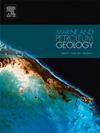Feldspar dissolution controlled by coal-measure fluids and the impacts on pore structure of tight sandstone reservoirs: The case of the Jurassic Badaowan Formation in the Junggar Basin, Northwestern China
IF 3.7
2区 地球科学
Q1 GEOSCIENCES, MULTIDISCIPLINARY
引用次数: 0
Abstract
Diagenetic fluids from coal measures are crucial for feldspar dissolution within feldspar-rich reservoirs. The intensity of feldspar dissolution and the distribution of kaolinite and quartz collectively shape reservoir pore structures, thereby influencing their quality. This study innovatively quantifies the impact of varying degrees of diagenetic alteration by coal-derived organic acids on pore structures and reservoir properties, employing petrographic and geochemical methodologies in the Mobei and Mosuowan uplifts. The results reveal that authigenic minerals predominantly originate from K-feldspar dissolution facilitated by coal-measure organic acid fluids. They tend to precipitate in situ within intergranular pores through diffusion in a relatively closed diagenetic system. Detailed analysis indicates that feldspar dissolution exerts a limited impact on porosity improvement, with permeability reduction primarily attributed to authigenic mineral precipitation blocking pore throats. The Mobei reservoirs exhibit high porosity and permeability characteristics, driven by well-developed network pore structures featuring effectively connected pore-throat systems, contributing 88.8 % to permeability. In contrast, the Mosuowan reservoirs, closer to coal-measure source rocks, undergo more intensive diagenetic modification, resulting in lower compositional and structural maturity. They primarily exhibit relatively high-porosity but low-permeability reservoirs, dominated by tree-like pore structures associated with clay minerals. This study constructed models of reservoir property evolution and pore structure modification, highlighting the critical role of distance from coal seams in shaping differences in feldspar dissolution and authigenic mineral distribution, contributing to the comprehensive research of coal-measure tight sandstones.
求助全文
约1分钟内获得全文
求助全文
来源期刊

Marine and Petroleum Geology
地学-地球科学综合
CiteScore
8.80
自引率
14.30%
发文量
475
审稿时长
63 days
期刊介绍:
Marine and Petroleum Geology is the pre-eminent international forum for the exchange of multidisciplinary concepts, interpretations and techniques for all concerned with marine and petroleum geology in industry, government and academia. Rapid bimonthly publication allows early communications of papers or short communications to the geoscience community.
Marine and Petroleum Geology is essential reading for geologists, geophysicists and explorationists in industry, government and academia working in the following areas: marine geology; basin analysis and evaluation; organic geochemistry; reserve/resource estimation; seismic stratigraphy; thermal models of basic evolution; sedimentary geology; continental margins; geophysical interpretation; structural geology/tectonics; formation evaluation techniques; well logging.
 求助内容:
求助内容: 应助结果提醒方式:
应助结果提醒方式:


